🎬 The Cult Cinema History: From Fringe to Phenomenon
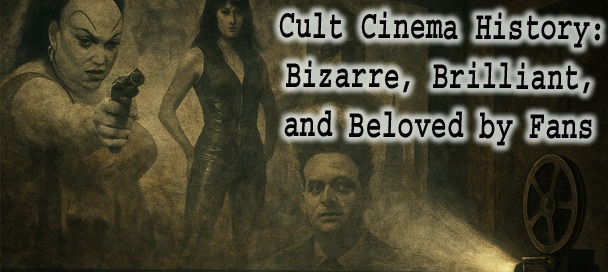
A vintage movie theater audience watches iconic cult film characters flicker across the screen
Cult cinema history is defined not by box office numbers, but by the enduring loyalty of its fans. These are the films that broke rules, defied mainstream sensibilities, and in many cases, were deemed too bizarre, offensive, or low-budget for traditional Hollywood success. Unlike studio blockbusters, cult movies often gain their following through word-of-mouth, late-night screenings, or home video rediscovery evolving into cultural touchstones for outsiders, rebels, and cinephiles alike.
This article explores the evolution of cult cinema history, tracing its roots from obscure exploitation films to celebrated cultural landmarks. Covering major eras including the sexploitation boom of the 1960s, the VHS revolution of the 1980s, and the internet-fueled rediscovery of the 2000s, it highlights how filmmakers like John Waters, Russ Meyer, Ed Wood, and Alejandro Jodorowsky helped define the strange and rebellious spirit of cult film. With fan-led revivals, boutique restorations, and film festival celebrations, cult cinema history continues to shape modern pop culture and influence new generations of creators and collectors.
Over time, what once played to half-empty midnight showings has transformed into a respected, even celebrated, niche within film studies. The history of cult cinema charts an unlikely journey: from grindhouse exploitation and drive-in sleaze to art-house reverence and critical reappraisal. Titles that were once dismissed as trash like Pink Flamingos, El Topo, or Faster, Pussycat! Kill! Kill! are now restored, reissued, and dissected in college film courses and retrospectives. Cult cinema history is no longer a fringe curiosity; it's an essential chapter in understanding the evolution of film as an art form.
The lasting appeal of cult films lies in their transgressive spirit. Whether it's the gleeful vulgarity of John Waters, the hypersexual bravado of Russ Meyer, the cardboard sincerity of Ed Wood, or the psychedelic mysticism of Alejandro Jodorowsky, these auteurs created worlds unlike anything in mainstream media. Camp, kitsch, shock value, and political rebellion all mix into a genre that resists easy classification one that's defined more by obsession than convention.
🧪 Origins of Cult Film (1920s–1950s)
Summary: Early poverty-row productions and outsider filmmakers like Ed Wood laid the foundation for cult cinema history with sincerity, shock, and shoestring budgets.
Cult cinema history in this era emerged from low-budget sci-fi, horror, and exploitation films that found audiences despite critical rejection.
Cult cinema history didn’t just pop up out of nowhere. They are the result of creative risks, low budgets, and a rebellious spirit that took hold in the early 20th century. These films became underground treasures that developed dedicated fans and timeless charm. Exploring the roots of cult cinema from the silent era to the rise of sci-fi hits reveals a story of passion, innovation, and outlandish storytelling.
The silent film era was a hotbed for experimentation. Filmmakers used innovative visuals and weird stories to draw viewers into strange worlds. This was a time when movie makers pushed boundaries, creating surreal and bizarre silent films that still fascinate today. From dreamlike sequences to bizarre narratives, the silent era was full of oddities that laid the groundwork for cult aesthetics.
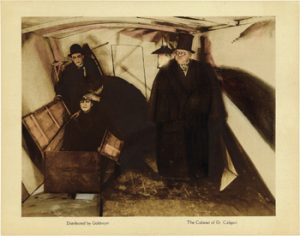
Lobby card from Caligari showing doctors examining Cesare
Films like The Cabinet of Dr. Caligari and Freaks stand out as silent oddities with lasting appeal. The influence of these films is clear they used eccentric visuals and shocking themes to challenge viewers. These movies gained underground followings because of their strange charm and daring stories. Film experts still mention their importance in shaping niche film communities that celebrate the bizarre.
Exploitation cinema aimed to shock and thrill audiences. These films often tackled taboo topics, making them popular with underground viewers. Titles like Old House on the Hill (1931) and Freaks (1932) pushed the limits of decency. They became part of a secret world of movies that thrived on controversy and shock value.
Low-budget studios such as Republic, Monogram, and PRC helped craft the cult film scene. These Poverty Row studios produced quick, cheap films that played on sensational topics. They didn’t need big stars or fancy sets just bold ideas and low costs. These studios became breeding grounds for outsider movies that fans still admire for their raw energy and campy charm.
We can not talks about Cult cinema history without Ed Wood is often called one of the original cult directors. His early movies, like Glen or Glenda (1953), are wildly earnest and wonderfully inept. His films are filled with awkward dialogue, cheesy special effects, and a love for storytelling that’s hard to find elsewhere. Wood’s DIY approach made his work a symbol of outsider filmmaking, inspiring future cult creators.
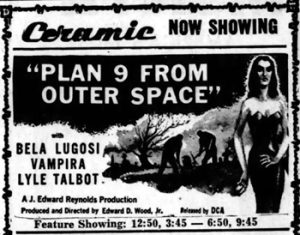
Plan 9 from Outer Space Theatrical advertisement from 1958
Plan 9 from Outer Space might be the most famous cult film of all time. Its troubled production and cheesy effects turned it into a legend. The film’s bizarre alien plot and low-budget look make it a favorite for midnight screenings and parodies. This movie proved that flaws and imperfections can turn a film into an icon, loved for reasons beyond traditional greatness.
The Cold War fueled a wave of sci-fi movies. Films like The Blob (1958) and Robot Monster (1953) played on fears of invasion and destruction. They did well at the box office but became cult hits mainly because of their odd effects and outlandish stories. These low-budget films captured audiences’ imagination at drive-ins and late-night screenings.
These movies often featured themes like alien invasions, apocalyptic worlds, and deep paranoia about technology. They used simple, practical effects that looked hilarious now but were innovative at the time. Their fun, bizarre stories made them perfect for midnight audiences and give them a timeless charm.
What sets these movies apart? Their campy style, surreal stories, and transgressive themes. They broke rules and didn’t care about mainstream standards. Today, many indie filmmakers look back at these roots to inspire their own rebellious projects. Recognizing the origins in Cult cinema history helps us better appreciate their cultural significance.
Read more about Ed Wood in our exclusive bio.
💋 Sexploitation & Shock: 1960s–1970s
Summary: Vixen! and Faster, Pussycat! Kill! Kill! mark pivotal moments in cult cinema history, defining the sexploitation era with bold themes and underground appeal.
The 1960s and 1970s marked a wild and unruly chapter in cult cinema history, as sexual liberation, political unrest, and countercultural energy collided on the silver screen. This era saw the rise of sexploitation films low-budget productions that thrived on nudity, taboo themes, and lurid marketing. Directors like Russ Meyer embraced the genre with unapologetic flair, crafting films that celebrated female power, oversized personalities, and absurdist humor. His breakthrough film Vixen! became one of the first American features to receive an X rating for sexual content alone and grossed millions despite (or because of) its controversial nature.
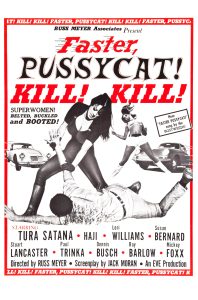
Poster art for Russ Meyer’s provocative 1968 film Vixen!, which challenged censorship norms and redefined exploitation cinema.
Meyer’s most enduring contribution to cult cinema history, Faster, Pussycat! Kill! Kill!, wasn’t an immediate hit, but later earned its place as a feminist touchstone and exploitation classic. With its leather-clad anti-heroines, desert brawls, and pulpy energy, it captured the chaos of a changing era. While mainstream Hollywood cautiously dipped its toes into the sexual revolution, sexploitation films jumped headfirst into it, providing an outlet for stories that were often too raw or provocative for traditional cinema.
Meanwhile, the underground film scene was exploding with shock value and transgression. John Waters made his mark with a string of defiantly grotesque films, most infamously Pink Flamingos (1972), which featured acts so outrageous they still provoke walkouts today. Waters became a cult figure for his ability to blend absurdity, satire, and filth into something both confrontational and oddly endearing. His work, much like Meyer’s, challenged viewers to rethink good taste, art, and the boundaries of storytelling.
At the same time, figures like Alejandro Jodorowsky introduced surrealism to cult cinema history through mind-bending works like El Topo and The Holy Mountain. These films were soaked in symbolism, mysticism, and psychedelic imagery, often with little regard for linear narrative. Audiences looking for meaning found entire religions in Jodorowsky’s metaphysical epics, while others were simply mesmerized by their visual audacity.
One of the most surprising moments in this chapter of cult cinema history came when Pulitzer Prize-winning critic Roger Ebert wrote the screenplay for Russ Meyer’s Beyond the Valley of the Dolls a campy, chaotic, sex-drenched satire that baffled critics but delighted fans. That collaboration bridged the gap between underground chaos and mainstream credibility, proving that even the most outrageous corners of cinema had value beyond shock.
These two decades were a fertile ground for experimentation, rebellion, and cult status. Films that once played to seedy theaters and underground venues are now archived, analyzed, and revered not despite their excesses, but because of them. This era didn’t just push boundaries it gleefully bulldozed them, helping define the very essence of what cult cinema could be.
💥 Explore the wildest moments in cult cinema history with our feature: Wild, Weird & Unforgettable: Top 5 Russ Meyer Movies.
🧛 Midnight Movie Explosion (1970s–1980s)
Summary: The midnight screening phenomenon cemented cult cinema history as a fan-driven movement with films like The Rocky Horror Picture Show and Eraserhead.
Cult cinema history during this time was shaped by surrealism, rebellion, and interactive theater experiences that defied conventional film culture.
The midnight movie craze changed how people watch films. These screenings became more than just watching movies they became social events. During the 1970s and 1980s, fans flocked to theaters and homes to celebrate films that pushed boundaries. Iconic titles like The Rocky Horror Picture Show and Eraserhead shaped a new kind of fandom. College campuses and repertory theaters fueled this movement, while cable TV brought cult movies into millions of living rooms.
In the early '70s, mainstream cinemas focused on blockbusters. But a new crowd wanted something different. Night owls craved films that challenged norms weird, wild, or just plain weird. Theaters started hosting late-night screenings that drew dedicated fans who loved cult and art films.
Films like El Topo released in 1970, kickstarting the phenomenon. Then came Pink Flamingos in 1972, pushing boundaries of shock. But nothing cemented the movement more than The Rocky Horror Picture Show in 1975. It became a staple for midnight audiences around the world.
Fans didn't just watch they participated. They yelled lines, brought costumes, and threw props. The midnight movie became a communal ritual, blending theatre and rebellion. Audience antics made each screening unique, creating a sense of belonging for fans of offbeat cinema.
When The Rocky Horror Picture Show opened, some critics dismissed it. But audiences loved its camp, humor, and music. Over time, it became a cult hit with a huge following. Fans embraced its eccentric charm and made it an audience-participation party.
Theaters began encouraging fans to shout lines like "It's just a jump to the left" and toss popcorn or rice. Costumes and props became part of the fun. Shadow casts people performing the movie live kept the energy high during showing after showing.
These traditions sparked a wave of fan-led events and parodies. Anniversary screenings still draw big crowds. The film influenced everything from drag culture to costume parties. Its dedicated fans kept the spirit alive for decades.
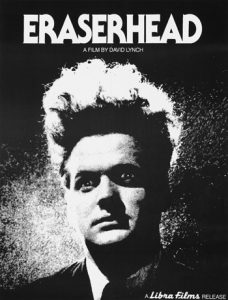
Original poster art for David Lynch’s surreal cult classic Eraserhead
Released in 1977, Eraserhead was strange and haunting. Its gritty visuals and surreal story drew a niche audience. It became a midnight fixture because it refused to fit into normal film categories. Films like Eraserhead offered an artistic rebellion. They opened doors for daring filmmakers and fans looking for something different. These movies proved that cinema could be as experimental as art itself.
Many students started hosting their own screenings of unusual films. Universities served as safe spaces for experimenting with film. Student-led clubs introduced new audiences to cult and experimental movies.
Old theaters dedicated to screening classics, foreign films, and cult favorites kept these movies alive. They hosted curated series, attracting dedicated fans who wanted deep dives into niche cinema. These theaters created tight-knit communities that shared a love for offbeat films.
The Brattle Theatre in Boston and the Nuart Theatre in Los Angeles are prime examples. These venues became legendary for their curated shows, fostering underground film scenes for decades. Shows like Night Flight, The Movie Loft, and Night Owl Theater filled late-night hours with cult and obscure films. They made rare movies available to a broad TV audience.
Cable TV broke down the barriers to cult films. No longer were these movies confined to theaters; they were part of TV schedules, reaching millions. Fans could watch Pink Flamingos or Eraserhead from their couches, sparking new interest.
🔪 VHS & Home Video Era (1980s–1990s)
Summary: The 1980s VHS boom expanded cult cinema history by bringing slasher flicks and forgotten gems directly into homes, creating a new kind of film fandom.
The advent of home video technology in the 1980s marked a massive turning point in cult cinema history. With the rise of VHS, suddenly anyone with a VCR could access strange, obscure, or previously censored films without needing to live near an art-house theater or attend midnight screenings. This accessibility turned private living rooms into personal grindhouses, giving new life to forgotten B-movies and introducing fresh generations to the bizarre brilliance of cult filmmaking.
Slasher flicks flourished during this period, with titles like Sleepaway Camp, The Slumber Party Massacre, and Basket Case becoming overnight rental sensations. These films cheaply made but loaded with gore, dark humor, and outlandish twists became cult staples thanks to word-of-mouth and video store shelf appeal. The garish cover art practically dared viewers to take a chance, and many did, discovering the thrill of unpolished horror that didn’t play by the rules.
In the UK, the VHS era brought controversy with the rise of so-called “video nasties.” These were violent, often low-budget horror films banned or censored for their explicit content. Ironically, the attempts to suppress them only boosted their cult status. Films like Cannibal Holocaust, I Spit on Your Grave, and The Evil Dead gained notoriety through moral panic, further solidifying their place in cult cinema history. Collectors and fans went out of their way to track down bootlegs or uncut imports, fostering an underground trade that elevated these films to legendary status.
The home video boom also paved the way for independent studios to thrive. Companies like Full Moon Features, Troma Entertainment, and Cannon Films pumped out a steady stream of low-budget oddities with high entertainment value. From Puppet Master to Toxic Avenger, these movies bypassed theaters and went straight to VHS, cultivating loyal fanbases and entire subcultures around their unique aesthetic. These weren’t just films they were movements, and they thrived outside the system.
Comedic cult films also found fertile ground during this era. Alex Cox’s Repo Man and Kevin Smith’s Clerks proved that weird, dialogue-heavy, low-budget comedies could become pop culture touchstones through sheer originality and clever distribution. Both movies earned acclaim not just from critics, but from fans who saw their own outsider sensibilities reflected in the characters and storytelling. Their success added a new dimension to cult cinema history one that wasn’t always tied to horror, sex, or shock.
Perhaps no film series better represents the VHS cult boom than Sam Raimi’s Evil Dead trilogy. Starting with a shoestring horror film shot in the woods, Raimi’s mix of slapstick gore, camera innovation, and Bruce Campbell’s iconic performance as Ash created a franchise that grew bigger and more bizarre with each installment. Evil Dead 2 and Army of Darkness didn’t just follow the cult formula they helped redefine it for the video age.
By the end of the 1990s, the home video era had democratized cult cinema. Films no longer needed theatrical runs or festival exposure to find their audience. If you could shoot it, tape it, and get it on a shelf, you had a shot at cult status. For many filmmakers, VHS wasn’t just a format it was freedom. And for fans, it was a gateway into the weird, wild world of cult cinema history.
📼 Internet & Rediscovery (2000s–2010s)
Summary: Cult cinema history in the 2000s was revived by the internet, with forums, streaming, and boutique labels preserving obscure classics.
The 2000s ushered in a digital renaissance that forever changed the trajectory of cult cinema history. As DVD replaced VHS and the internet became a global force, obscure films that once languished in analog limbo were suddenly resurrected, restored, and reexamined by a new wave of fans, critics, and collectors. Message boards, torrent sites, and fan blogs became treasure troves for discovery, where titles long considered “lost” reemerged through pixelated uploads or limited-edition reissues.
Fan forums and early YouTube channels played a critical role in introducing younger audiences to cult oddities. Whether it was an in-depth analysis of Hausu or a meme-fueled celebration of Troll 2, digital spaces helped spread awareness faster than any theater or rental shelf ever could. In this era, cult cinema history wasn't just preserved it was crowd-sourced. Enthusiasts became curators, building Letterboxd lists, fan sites, and home-brew documentaries that turned even the most obscure releases into must-watch sensations.
Specialty distributors emerged as champions of forgotten gems. Labels like Vinegar Syndrome, Severin Films, and Arrow Video began restoring grindhouse flicks, sexploitation oddities, and regional horror movies in stunning HD, often with more care than the films had ever originally received. These boutique companies not only preserved cult cinema history they elevated it, giving it the prestige treatment that mainstream studios rarely afforded.
Meanwhile, modern filmmakers joined the conversation by embracing the aesthetic and spirit of their cult predecessors. Quentin Tarantino and Robert Rodriguez’s Grindhouse double feature paid homage to the sleaze and grime of 1970s cinema, while directors like James Gunn and Ti West borrowed heavily from the genre’s tropes and attitude. Their success helped introduce new audiences to the roots of cult cinema history, often inspiring them to dig into the original films that influenced their heroes.
This period also gave rise to new cult icons born directly from the digital world. Tommy Wiseau’s The Room became a viral sensation thanks to its baffling dialogue, strange acting choices, and complete narrative breakdown earning its place in cult cinema history not from a traditional release, but from internet-fueled midnight screenings and quote-along viewings. Likewise, Neil Breen’s surreal and baffling self-produced films turned him into a 21st-century Ed Wood, celebrated precisely because of his unfiltered creative vision.
By the close of the 2010s, the internet had permanently shifted how cult films were discovered, shared, and celebrated. No longer tied to specific theaters or formats, cult cinema history entered a decentralized golden age one where the audience had just as much power as the director in shaping a film’s legacy. It was no longer just about the movies it was about the community, the hunt, and the joy of finding something gloriously strange in a sea of sameness.
📢 Cult Film Festivals & Conventions (Ongoing)
Summary: Modern film festivals and midnight screenings showcase how cult cinema history thrives today through interactive fan communities and genre celebrations.

Audience enjoying a late-night screening at a cult film festival
Today’s cult cinema history lives on not just through screens, but in person at film festivals, conventions, and midnight movie revivals around the world. Events like the Alamo Drafthouse’s Weird Wednesday, Fantastic Fest, and The Cinefamily's Everything Is Terrible! showcase oddball classics and forgotten gems to sold-out crowds, often with cast Q&As or live commentary.
Conventions celebrate the fan culture surrounding these films, offering screenings of The Room, Troll 2, and Rocky Horror Picture Show with full audience participation. Cosplay, merch tables, and themed panels give cult fans a space to share their obsession and discover new favorites. These gatherings keep cult cinema history alive not just through nostalgia, but through active celebration of its weird, wonderful legacy.
🏆 Legacy and Cultural Impact
Summary: From critical reappraisal to academic study, cult cinema history now holds a permanent place in pop culture’s weirdest and most beloved corner.
Cult cinema history has moved from the margins to the mainstream, influencing everything from fashion to academic study. Once-dismissed films are now preserved in archives, screened at major festivals, and analyzed in university classrooms. Directors like Peter Jackson and Quentin Tarantino built their careers on cult influences, proving that outsider art can reshape popular culture.
Today, the legacy of cult cinema lives on through streaming platforms, collector reissues, and a global fanbase that values originality over polish. What began as rebellion is now recognition and cult cinema history continues to grow with every new generation that discovers the beauty in the bizarre.
🧠 Further Reading & Resources
📖 Read: The 40 Greatest Movies in Cult Cinema History - Forbes
🔍 Explore: Cult Cinema History - What Is It? Evolution & Enduring Appeal

ML Lamp is the owner of Kilroy Was Here. After his 20 years of working in Las Vegas in the entertainment promotions field, Mr. Lamp retired in 2002 from his job to pursue his passion for collectibles. Now as a guest speaker and author he’s living the dream, and sharing his warmth with You.





